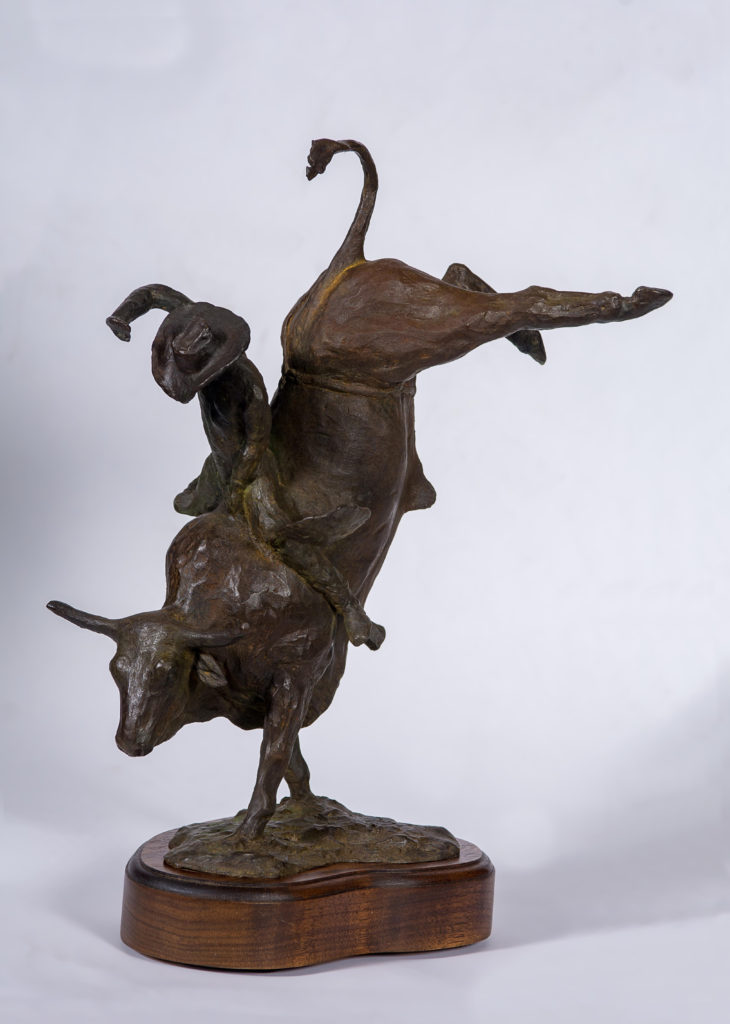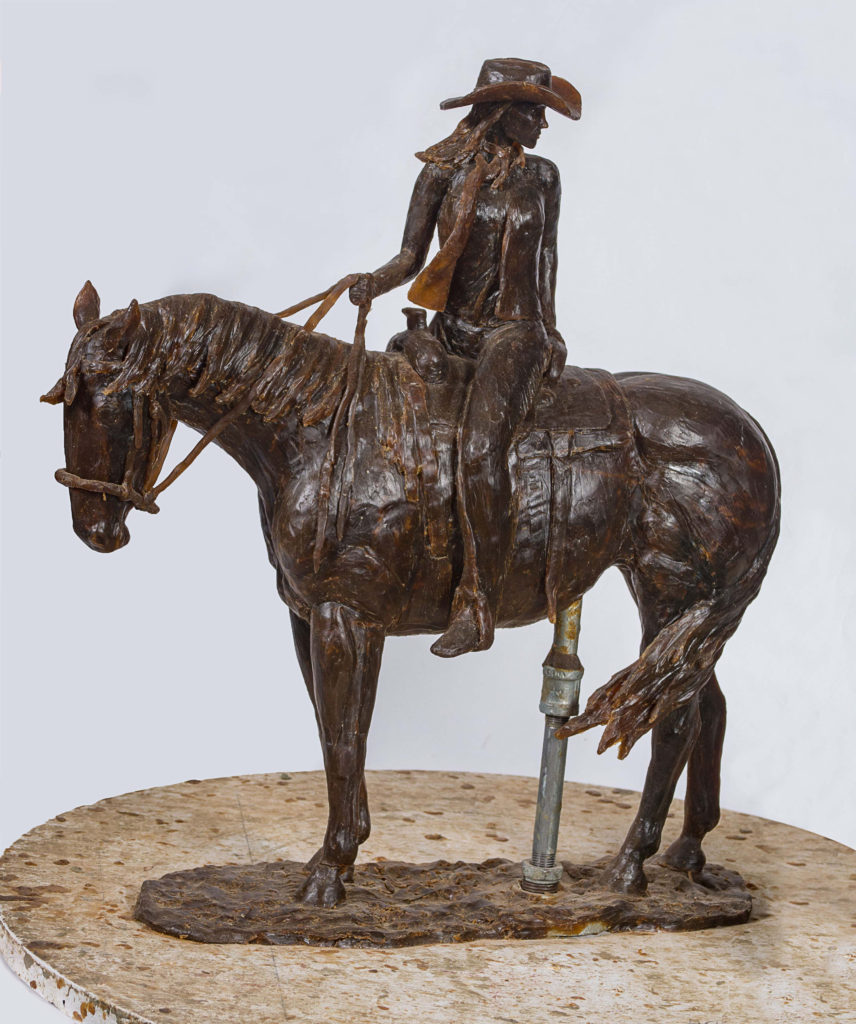Sue Kern-Fleischer
Photography Courtesy Arizona Fine Art EXPO
[dropcap]W[/dropcap]hen Stacy Bayne and Jerry Vaughn begin to work with blocks of clay, they both get lost in their subject matters. For Bayne, the clay becomes a conduit for hope as she sculpts beautiful, culturally-unique angels. For Vaughn, a fourth-generation rancher, sculpting the clay is instinctive as he captures the spirit of the cowboy.
Both artists are self-taught, and both prefer sculpting freely, with limited or no use of an armature. Both began sculpting later in life after being in the spotlight for many years. Bayne traveled the world working as a model; Vaughn competed in national and regional rodeos as a team roper.
While on different paths, the two artists’ lives will intersect as they spend 10 weeks creating original work at the Arizona Fine Art EXPO, open daily from 10 a.m. to 6 p.m., rain or shine, January 11 to March 24. Known as one of Arizona’s best venues for collecting fine art, the event features 124 patron-friendly artist studios within a 44,000-square-foot space under the festive white tents on the southwest corner of Scottsdale and Jomax Roads, next to MacDonald’s Ranch.
“When we jury artists into our show, we not only look at the quality of work, we take into consideration how their presentation will enhance our patrons’ experience,” said Judi Combs, Arizona Fine Art EXPO co-founder. “We want people to interact with our artists, see them in action, and learn about their passion, inspiration and techniques.”
Angels for Healing
Before October, Stacy Bayne had an idea of what she might exhibit during her second year at Arizona Fine Art EXPO, but then the mass shooting at Squirrel Hill Synagogue in Pittsburgh happened. Bayne had been disturbed by so many mass shootings before, but this one jolted her into taking action.
“My heart was so heavy, but I began sculpting through my tears,” the Colorado sculptor said. “I had already been creating angels, but I was compelled to do more. I started a new collection, ‘Angels for Healing,’ and I’ve been sculpting furiously in my studio ever since.”
The new collection will offer hope for people dealing with everything from grief and debilitating diseases, like cancer, to bullying and gun violence. Her first series, “Hold on to Hope” will be unveiled at the Arizona Fine Art EXPO.
The angels are pressure-cast with new material for Bayne that consists of bonded stone and white cement. Each angel varies in size and cultural background, and several are holding doves. The series also includes wall-mounted angels and sculpture and mixed media pieces.
“Hope soars on the wings of an angel,” Bayne said, adding that her sculptures don’t represent any religion. “There’s a spiritual, calming effect of angels, and everyone can benefit from having an angel these days.”
From Dolls to Sculpture
Bayne’s life certainly has not been boring. A former fashion model, she lived in five countries before finding commercial success creating porcelain dolls.
Back then, as a single mother of two-year-old twins and a three-year-old, she sold her work in doll magazines and also competed in and won many national competitions. Before she knew it, she was one of the top sellers on the Home Shopping Network.
Years later, after moving to Dallas, Bayne attended a signing event where she met the world-renowned sculptor Giuseppe Armani. Because she spoke Italian, he invited her behind the roped off area where, over a five-hour period, he shared some of his sculpting tips.
“That was my aha moment! The experience completely changed my approach and understanding of my talent as well as my future endeavors,” Bayne said.
In 1997, she began to work as the creator and artist of a home décor line of sculpture titled ‘The Maasai Collection.’ The collection went on to sell in over 21 countries over the next seven years.
She began experimenting with bronze in 2005, and created her first angel in 2008, after losing a dear friend to cancer. The angel had red curly locks, just like her Irish friend.
Sculpting angels was put on hold when the Great Recession hit. After her father passed in 2013, she found her passion for sculpting again and she also began experimenting with mixed media pieces.
Now on a mission, she draws upon her intuition to guide her as she sculpts.
“I don’t use photographs, and I don’t use an armature, not even with my life-size pieces,” she said. “I sculpt from my mind’s eye.”
Guests to the Arizona Fine Art EXPO can watch her sculpt angels and see some of her mixed media pieces, which delve into the history of our country’s railroad expansion. The three-dimensional wall sculptures are created with pages from rare tariff books from the late 1800s and early 1900s. Bayne hopes viewers will reflect upon the bigger picture of the railroads and how the expansion impacted Native Americans, bison and other wildlife.
Cowboy Returns Home
Jerry Vaughn was 40 years old when he discovered his passion for sculpting. He credits his daughter with helping him discover his talent.
“She came home from school with a sculpting project, and I started helping her. After that, I was hooked,” Vaughn said.
Growing up on ranches, first in Arizona and then in Oklahoma, Vaughn lived the life of a cowboy. Junior rodeo was a family affair and many happy hours were spent in the arena. As an adult, he was an active team roper whose work took him to several states, including Texas, where he settled and began creating art.
Naturally, Vaughn first began sculpting Western subjects. The movement of the horse, the bucking bull, the roping cowboy and cowgirl all came to life in his imagination.
As a child, he was fascinated with horses. “My grandfather would take me to look at them and learn their anatomy. He would point out their features and help me understand what they were best built for,” he said.
Decades later, when he first started sculpting, he would take a sculpting tool and pretend he was brushing a horse to follow the contours of its build and muscles. Now he often imagines himself on a horse or a bull so he can correctly sculpt stride, footing and other details.
“I want people to connect with my pieces and recognize that they’re not only anatomically correct, the motion reflects a true rodeo or ranch scene,” he said.
He prefers to sculpt freely, without measurements and just one armature so he can move the piece easily as he sculpts. Self-taught, he has extensive experience working in a foundry, and he credits Hefestus Fine Arts Bronze Casting with letting him work beside them on projects.
“I am very fortunate in that they allow me to be involved with all aspects of bronze casting, through the lost wax process,” he said.
Last year, he began sculpting figurative female pieces. “I’m trying to capture the beauty and delicate nature of women. It’s been challenging, but I’m enjoying it.”
Vaughn recently moved back to Arizona, and he’s looking forward to his second year exhibiting at the Arizona Fine Art EXPO.
“It’s been a wonderful experience, and I enjoy the camaraderie,” Vaughn said, adding that he feels grateful to have found his calling as a fine artist. “I feel so much joy when I sculpt. It almost feels like I’m off the ground in the air.”
Arizona Fine Art EXPO
January 11 to March 24 | 10 a.m.–6 p.m. daily, rain or shine | 26540 N. Scottsdale Rd., Scottsdale
Season passes $10; seniors and military $8; children under 12 free. Free parking. | arizonafineartexpo.com










Comments by Admin